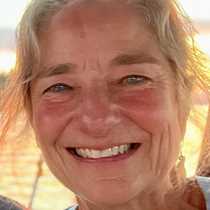Magdalena Bay
Early this morning we pulled up anchor and headed further north in Magdalena Bay, to a place called ‘El Barril,’ where sand dunes and mangroves narrow the bay. We explored by Zodiac, searching the mangroves for birds, and peering into the clear, shallow water at the red mangrove’s arching prop roots. Some of us kayaked, and when we landed on shore and first stepped on to the sand, each one of us got a very distinct ‘sinking feeling.’ No, it wasn’t an eerie feeling of foreboding on a bright sunny day; it was more like, well, sinking down into wet sand, that’s all. In this spot, the sand dunes crept right to the water’s edge.
The day was warm and perfectly clear, so lunch was served under a bright, blue sky on the ship’s sun deck. As we sipped Tequila Sunrise drinks, the Sea Bird motored southward, and by early afternoon, we were anchored across the sand dunes from a place we call Sand Dollar Beach.
In some ways sand is more like liquid than solid; as long as the wind blows the sand is always in motion. A beetle trudges along, leaving tracks that look like he was riding a miniature mountain bike. In less than a minute, they are erased. We saw coyote tracks, and large shell middens, believed to be left by early native inhabitants. As the wind blows and each sand grain is carried along, tracks are erased, dunes creep downwind, middens are hidden, and others uncovered. The only anchors are the plants, whose roots hold down the sand, at least for a while. Where sand verbena, sea purslane and loco weed grew, we found beautiful little flowers.
Sand Dollar Beach is aptly named. They are huge, and there are lots of them. The live animals are covered with short, velvety brown spines. Most that we found were smooth and had been bleached by the sun. The five-petal flower is where tube feet had poked through the test. The sea had tossed up other treasures: scallops, cockles, pelican skeletons, and even the skulls of bottlenose and common dolphins. This truly felt like a wild beach.
A nearly full moon rose shortly before sunset, and brilliant Venus shone in early evening. We left Magdalena Bay, past plunging pelicans, and continued on our journey. By sunrise, we will be nearing Cabo San Lucas. Berit Solstad, Naturalist
Early this morning we pulled up anchor and headed further north in Magdalena Bay, to a place called ‘El Barril,’ where sand dunes and mangroves narrow the bay. We explored by Zodiac, searching the mangroves for birds, and peering into the clear, shallow water at the red mangrove’s arching prop roots. Some of us kayaked, and when we landed on shore and first stepped on to the sand, each one of us got a very distinct ‘sinking feeling.’ No, it wasn’t an eerie feeling of foreboding on a bright sunny day; it was more like, well, sinking down into wet sand, that’s all. In this spot, the sand dunes crept right to the water’s edge.
The day was warm and perfectly clear, so lunch was served under a bright, blue sky on the ship’s sun deck. As we sipped Tequila Sunrise drinks, the Sea Bird motored southward, and by early afternoon, we were anchored across the sand dunes from a place we call Sand Dollar Beach.
In some ways sand is more like liquid than solid; as long as the wind blows the sand is always in motion. A beetle trudges along, leaving tracks that look like he was riding a miniature mountain bike. In less than a minute, they are erased. We saw coyote tracks, and large shell middens, believed to be left by early native inhabitants. As the wind blows and each sand grain is carried along, tracks are erased, dunes creep downwind, middens are hidden, and others uncovered. The only anchors are the plants, whose roots hold down the sand, at least for a while. Where sand verbena, sea purslane and loco weed grew, we found beautiful little flowers.
Sand Dollar Beach is aptly named. They are huge, and there are lots of them. The live animals are covered with short, velvety brown spines. Most that we found were smooth and had been bleached by the sun. The five-petal flower is where tube feet had poked through the test. The sea had tossed up other treasures: scallops, cockles, pelican skeletons, and even the skulls of bottlenose and common dolphins. This truly felt like a wild beach.
A nearly full moon rose shortly before sunset, and brilliant Venus shone in early evening. We left Magdalena Bay, past plunging pelicans, and continued on our journey. By sunrise, we will be nearing Cabo San Lucas. Berit Solstad, Naturalist




